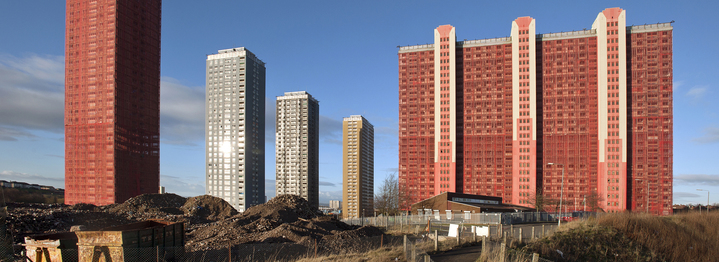Red Road

There were 15 different areas in Glasgow included in GoWell – one of which was Red Road. Our study area boundaries for Red Road are shown on the map.
We also studied the wider area surrounding the multi-storey flats. For information on that area visit the Wider Red Road study area page.
Why
We were interested in studying Red Road because was is part of the regeneration programme that took place in Glasgow. This involved a range of activities such as building new homes, refurbishment, demolition and efforts to give communities more of a voice and to support communities with improved services and amenities. These activities provided an opportunity to find out from local residents if and how their health and lives changed as a result of investment in their homes and neighbourhoods.
What
We carried out a number of resident surveys over our 14 year study. These consisted of interviews conducted face-to-face in people’s homes and included a whole range of questions about how people felt about their homes, their neighbourhood, services in the area, their lifestyle and circumstances and their health and wellbeing.
Over time this helped us understand more about the process of neighbourhood regeneration, and to highlight what was working well for communities and what needed more attention.
If you were involved in one of our surveys you can find additional information about your participation here.
We conducted four surveys in Red Road: in 2006 in which 327 residents were interviewed; 2008 in which 231 residents were interviewed; 2011 in which 196 residents were interviewed; and 2015 in which 105 residents were interviewed. In total, 859 interviews took place.
Findings
A small selection of findings from these four surveys with Red Road residents are shown below:
- In 2015, 88% of residents were satisfied or very satisfied with their home. This is a big increase from had declined from 66% in 2006.
- In 2015, 85% of participants were very or fairly satisfied with their neighbourhood as a place to live. This had increased from 61% in 2006.
- 77% of participants felt part of their community in 2015. In 2008, when this question was first asked, it was much lower, at 55%.
- 74% of participants rated their general health as excellent or good in 2015. This has fallen from 84% in 2006.
- In terms of empowerment, 38% of participants in 2015 felt that on their own, or with others, they could influence decisions affecting their local area. This was an increase from 21% in 2006.
Over the 14 years of the study we widely shared and discussed the findings from the community surveys with various service providers across Glasgow to encourage them to consider the findings when planning and prioritising services and amenities. They were used by a wide range of stakeholders including local communities, housing and regeneration organisations and local and national government.
We also regularly summarised and shared the area findings with the communities involved through our community newsletters. The last newsletter for this area can be accessed below.